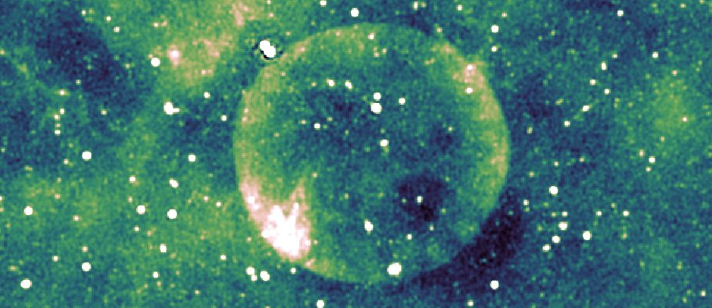Astronomers Discover ‘Teleios’—A Mysterious Perfect Sphere

© Filipović et al., arXiv, 2025
In a universe renowned for its chaotic and irregular structures, the recent discovery of an almost perfectly sphere like object has left astronomers both intrigued and puzzled.
Named Teleios, derived from the ancient Greek word for “perfection,” this celestial sphere challenges conventional understanding of supernova remnants.
Unveiling Teleios: A Cosmic Enigma
Utilizing data from the Australian Square Kilometre Array Pathfinder (ASKAP) radio telescope, researchers identified Teleios as a faintly glowing, spherical bubble in the Milky Way. The object emits solely in radio wavelengths, suggesting it is the remnant of a Type Ia supernova—a thermonuclear explosion of a white dwarf star in a binary system. However, the near-perfect symmetry of Teleios is atypical for such remnants, which are usually distorted by interactions with the surrounding interstellar medium.

The Distance Dilemma
Determining the exact distance to Teleios has proven challenging, with estimates ranging between approximately 7,175 and 25,114 light-years. This uncertainty significantly impacts interpretations of its size and age:
- At 7,175 light-years, Teleios would span about 46 light-years and be less than 1,000 years old.
- At 25,114 light-years, it would extend approximately 157 light-years and be over 10,000 years old.
Complicating matters further, the absence of expected X-ray emissions—typically associated with Type Ia supernova remnants—adds to the mystery.
Alternative Theories: A ‘Zombie’ Star?
One hypothesis posits that Teleios could be the aftermath of a Type Iax supernova, a less energetic explosion that doesn’t completely destroy the white dwarf, leaving behind a “zombie” star. This scenario would place Teleios at a closer distance of about 3,262 light-years, with a diameter of roughly 11 light-years. While a potential candidate star exists at this distance, other measurements do not support this proximity, leaving the theory unconfirmed.

Implications for Astrophysics
The discovery of Teleios challenges existing models of supernova remnants and their interactions with the interstellar environment. Its near-perfect spherical shape suggests an explosion in an unusually uniform medium or a previously unrecognized mechanism influencing its formation. Further multi-wavelength observations and refined distance measurements are essential to unravel the true nature of this enigmatic structure.
You might also want to read: What Is a Supernova?


